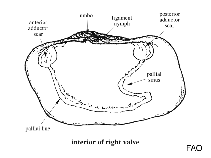Advertisement
Panopea abrupta (Conrad, 1849)
Pacific geoduck clam| Native range | All suitable habitat | Point map | Year 2050 |

|
| This map was computer-generated and has not yet been reviewed. |
| Panopea abrupta AquaMaps Data sources: GBIF OBIS |
Upload your photos
Google image | No image available for this species;
drawing shows typical species in Hiatellidae.
Google image | No image available for this species;
drawing shows typical species in Hiatellidae.
United States (contiguous states) country information
Common names:
[No common name]
Occurrence: native
Salinity: marine
Abundance: abundant (always seen in some numbers) | Ref: Goodwin, C.L. and B. Pease, 1989
Importance: | Ref:
Aquaculture: never/rarely | Ref:
Regulations: no regulations | Ref:
Uses: no uses
Comments: C: Refs. 78828, 78831, 93916; R: Ref. 95344.
National Checklist:
Country Information: https://www.cia.gov/library/publications/resources/the-world-factbook/geos/us.html
National Fisheries Authority: http://www.nmfs.gov
Occurrences: Occurrences Point map
Main Ref: Goodwin, C.L. and B. Pease, 1987
National Database:
Occurrence: native
Salinity: marine
Abundance: abundant (always seen in some numbers) | Ref: Goodwin, C.L. and B. Pease, 1989
Importance: | Ref:
Aquaculture: never/rarely | Ref:
Regulations: no regulations | Ref:
Uses: no uses
Comments: C: Refs. 78828, 78831, 93916; R: Ref. 95344.
National Checklist:
Country Information: https://www.cia.gov/library/publications/resources/the-world-factbook/geos/us.html
National Fisheries Authority: http://www.nmfs.gov
Occurrences: Occurrences Point map
Main Ref: Goodwin, C.L. and B. Pease, 1987
National Database:
Common names from other countries
Classification / Names Common names | Synonyms | Catalog of Fishes (gen., sp.) | ITIS | CoL | WoRMS
Environment: milieu / climate zone / depth range / distribution range Ecology
Benthic; depth range 0 - 110 m (Ref. 78828). Temperate, preferred 8°C (Ref. 107945); 59°N - 23°N, 129°E - 106°W
Distribution Countries | FAO areas | Ecosystems | Occurrences | Introductions
Pacific Ocean: from Gangwon, South Korea to East Bering Sea, Alaska south to Baja California, Mexico.
Length at first maturity / Size / Weight / Age
Maturity: Lm ? range ? - ? cmCommon length : 21.2 cm SHL male/unsexed; (Ref. 78831); max. published weight: 2.8 kg (Ref. 127152); max. reported age: 168 years (Ref. 127152)
Buries in a variety of substrates, mud, sand and gravel, along the intertidal zone (Ref. 95344).
Life cycle and mating behavior Maturity | Reproduction | Spawning | Eggs | Fecundity | Larvae
Simple annual reproductive cycle: gametogenesis begins in September, spawning begins from March to July.
Main reference
References | Coordinator | Collaborators
Bisby, F.A., M.A. Ruggiero, K.L. Wilson, M. Cachuela-Palacio, S.W. Kimani, Y.R. Roskov, A. Soulier-Perkins and J. van Hertum. 2005. (Ref. 19)
IUCN Red List Status
(Ref. 130435: Version 2024-2)
CITES status (Ref. 108899)
Not Evaluated
CMS (Ref. 116361)
Not Evaluated
Human uses
Fisheries: commercial
FAO - Aquaculture: production; Fisheries: landings | FishSource | Sea Around Us
Tools
More information
Internet sources
BHL | BOLD Systems | CISTI | DiscoverLife | FAO(Fisheries: ; publication : search) | GenBank (genome, nucleotide) | GloBI | Gomexsi | Google Books | Google Scholar | Google | PubMed | Tree of Life | Wikipedia (Go, Search) | Zoological Record
Estimates based on models
Preferred temperature
(Ref. 115969): 5.7 - 20.6, mean 12.1 (based on 518 cells).
Resilience
(Ref. 69278)
Medium, minimum population doubling time 1.4 - 4.4 years (K=0.11-0.49; tm=3.33; tmax=168).
Prior r = 0.37, 95% CL = 0.24 - 0.55, Based on 1 data-limited stock assessment.




